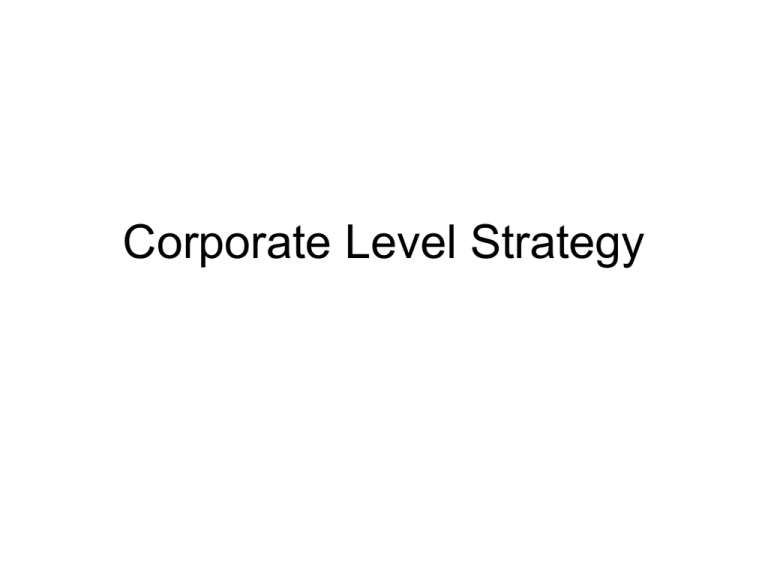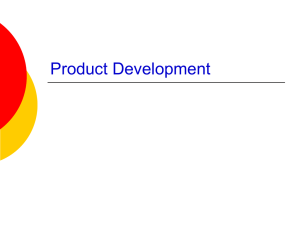Corporate Level Strategy
advertisement

Corporate Level Strategy Corporate Level Issues • Product Diversity • Corporate Parenting Roles • Managing the Portfolio • International Diversity The multi business organization Corporate Parent Businesses Businesses Businesses Three levels of strategy • Corporate Strategy • Business/ Competitive Strategy • Functional Strategy Corporate Strategy • An action taken to gain a competitive advantage through the selection and management of a mix of businesses competing in several industries or product markets Corporate Strategy (contd) • What should be the nature and values of the enterprise in the broadest sense ? • What businesses should we be in ? • What structure , systems and processes will be necessary to link the various businesses to each other ? • How can corporate centre add value ? Three major components • Growth Strategy • Portfolio Strategy • Corporate Parenting Strategy Product / Market Diversity • Diversification is a strategy that takes the organization into both new markets and products or service. • Economies of Scope • Corporate Managerial Capability • Increase market power • Hedge risks Related Diversification • Is strategy development beyond current products and markets , but within the capabilities or value network of the organization Nature and Scope of Corporate Strategies • Stability Strategies • Growth Strategy • Retrenchment Strategy • Combination Strategy Stability Strategy • Decides to serve the same markets • Pursue same objectives with incremental improvement of functional performance • Concentrates resources in a narrow product market for developing competitive advantage When Stability Strategy • • • • • The economy or industry is in turmoil Environmental turbulence is minimal Just off a period of growth Growth ambitions modest Industry in mature stage Approaches to Stability • Holding Strategy • Stable Growth • Harvesting Strategy • Profit or End Game Strategy Expansion Strategies • • • • • When the firm has lofty growth objectives When new opportunities are emerging Firm is the leader Firm has surplus resources Diversification fulfils growth objectives Expansion ( contd ) • Expansion through intensification – Ansoff’s product market expansion grid • Expansion through Integration Ansoff’s Product Market Expansion Grid Markets / Products Current Markets New Markets Current Product Market Penetration Market Development New Products Diversification Product Development Market Penetration • Motivating Existing Customers to buy more frequently • Increase efforts to attract it’s competitions’ customers • Targeting new customers – price concessions , better customer service Market Development Strategy • Tries to achieve growth by introducing existing products in new markets • Can move to new geographical areas • Can attract different market segments Product Development Strategy • Development of a new/ improved product for it’s current markets • Likely to succeed when the products have low brand loyalty • Carries risk with it . Diversification • Mergers & Acquisitions : Outright purchase of a company by another eg Tech Mahindra buys Satyam • Strategic Alliance & Joint Venture : Agreements between companies to form collaborative partnership eg Maruti-Suzuki • Internal Development : Organic growth into other LOBs eg Reliance, ITC Advantages of related diversification • Transferring skills, expertise, and capabilities from one business to another • Cob9ining the value chain • Leveraging strong brand names • Creating stronger capabilities Integration • Vertical Integration – either forward or backward into adjacent activities in the value network. Eg buying a car component company by a car manufacturer is BI whereas buying of a repair centre is FI. • Horizontal Integration is development to activities which are complementary to present activities. When to Vertically Integrate • Are our existing suppliers / customers meeting the needs of end customers ? Eg Nike outsourcing production units to SA& it’s logistics to FedEx . • How volatile is the current situation • Is it possible to influence the of our upstream/ downstream businesses? • Will Vertical Integration enhance the structural position of the business ? eg GCI integrated forward via www.saregama.com Advantages of Vertical Integration • Build Entry Barriers • Reduce Transaction Costs • Better control & coordination of operations • Spread fixed costs / overheads over large number of products/ services Limitations of Vertical Integration • Balancing the line • Forcing companies to commit to technologies / products and risk losing flexibility • Problem of integrating significantly different LOB into a coherent whole Unrelated Diversification • Is the development of products or services beyond the current capabilities or value network • Pays off by exploiting dominant logic • Conglomerate may be effective in countries with underdeveloped markets Advantages of Unrelated Diversification • Spreading business risks • Optimization of financial investments • Exploiting corporate resources and management capabilities Forms of Diversification • Vertical : Diversification across value chain • Horizontal : Diversification into complementary businesses • Geographic : Firms expand into other geographic areas International Expansion • Exporting • Licensing • Joint Venture • Direct Investment Exporting • Marketing of domestically produced goods in a foreign country • Advantage – minimizes risk , ensures speed of entry m maximizes scale using existing resources • Disadvantage – trade barriers and tariff add to cost , limits access to local market information , seen as outsider Licensing • Licensing permits a company in the target country to use the property of the licensor eg trademarks , patents , and production techniques • Advantage – high ROI, able to circumvent trade barriers • Disadvantage – lack of control over use of assets, license period is limited Joint Ventures • Partners strategic goal converge but competitive goal diverge • Partners size, resources , market power are small compared to the industry leaders • Advantage – viewed as insider, potential for learning , overcomes cultural distance • Disadvantage – Dilution of control, Knowledge spillovers, higher risk Direct Investment • It is the ownership of facilities in the target country • Greater knowledge of local market • Viewed as insider • Higher risk than other modes • Require more resources and commitment Reasons for international diversity • • • • • Globalization of Markets and Competition Suppliers follow customers Bypass limitations in home market Gain arbitrage on differences Internationalizing of value added activities International Strategy • Multi domestic strategy- Value adding activities are located in national individual markets served by the organization • Global Strategy Standardized products exploiting economies of scale . • Transnational : Seeks the best of both multidomestic and global strategy Creating value through corporate strategy • • • • • • Reducing Risk Maintaining growth Balancing Cash Flows Sharing Infrastructure Increasing Market power Capitalizing on core competence




